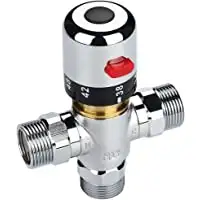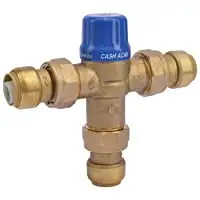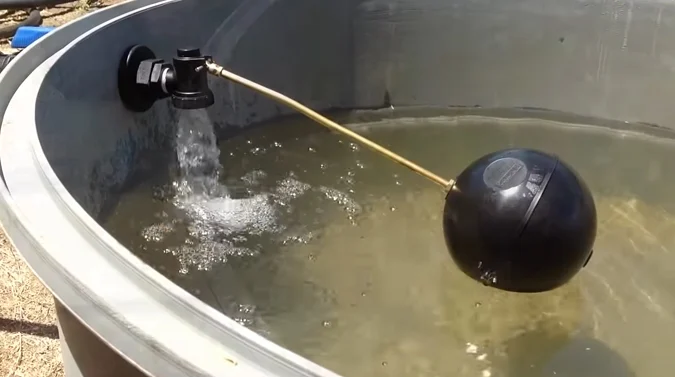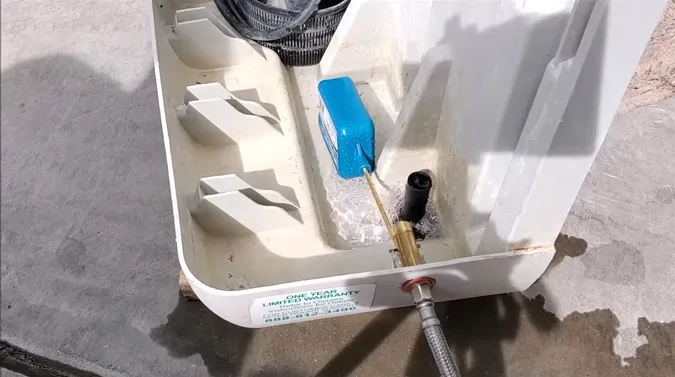Last Updated on August 22, 2023
Without a thermostatic mixing valve in your plumbing system, you would be at the mercy of the unpredictable temperature of your water from your taps or water heater. The water that flows into your home from the municipal supply & water heater can fluctuate in temperature depending on various conditions.
A thermostatic mixing valve helps to regulate the water temperature in a consistent manner. This ensures comfort and safety, as sudden changes in water temperature can be pretty jarring or scalding. The best thermostatic mixing valve can help with this process and leave you with less hot water to produce the desired temperature.
Thermostatic mixing valves are commonly used in domestic and commercial settings, but they are also recommended in homes with small children or for individuals who frequently bathe. Find out what to look for when selecting a thermostatic valve and discover the top five.

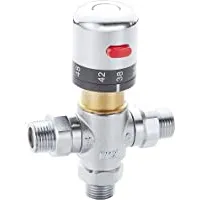
Fyeer 3-Way Thermostatic Mixing Valve
● Material: Copper
● Exterior Finish: Chrome,Brass
● Inlet Connection Type: National Pipe Tapered
● Outlet Connection Type: MNPT
How Does a Thermostatic Mixing Valve Work?

A thermostatic mixing valve blends cool and hot water, and the amount of hot water is limited, which protects against accidental burns & scalding. These valves are often used in residential applications, such as showers and sinks, and commercial environments, such as hospitals and schools.
The valve works by sensing the temperature of the water flowing through it and then mixing in freezing water if needed. This ensures that the water from the valve is always at a safe temperature. Thermostatic mix valves can be adjustable or non-adjustable.
Adjustable valves allow the user to set the desired output temperature, while non-adjustable valves have a factory-set temperature. Both types of valves are designed to provide many years of trouble-free operation.
What is the Difference Between a Regular Mixing Valve and a Thermostatic Mixing Valve?

The main difference between regular mixing valves and thermostatic mixing valves is that thermostatic valves can react and compensate for both temperature changes and pressure fluctuations, while regular mixing valves can only react to water pressure changes.
These mixing valves can provide a steadier and more reliable water flow, even when conditions change. This makes them ideal for use in applications where water temperature needs to be carefully controlled.
Recommendation for the Best Thermostatic Mixing Valve

The best water mixing valve for your home or business is the one that offers reliable performance and consistent temperature regulation. You may be interested in learning more about thermostatic mixing valves, or you may be ready to invest in one.
If so, here are the top four emergency thermostatic mixing valves to consider:
➤ Fyeer 3-Way Thermostatic Mixing Valve

The Fyeer 3-way thermostatic mixing valve is a premium product made of solid brass with a chrome finish. It connects to hot and cold water inlets and the mixer water outlet. This valve has a temperature range of 4-29 degrees Celsius for the freezing water supply and 55-85 degrees Celsius for the hot water supply.
Both inlets also have check valves inside them. The valve has a safety temperature stop of 38 degrees Celsius. The valve has two inlets with check valves inside, and it can keep the temperature constant within ±2 degrees Celsius.
What are the Benefits of this Product?
With the Fyeer thermostatic valve, you can easily control the water temperature for precision and reliability. Its solid brass construction and plastic knob are designed to last, and its ±2°C accuracy ensures that your water is always at an immaculate temperature.
Also, if your main water supply fails, this valve is equipped with a built-in check valve to prevent scalding and ensure that your water temperature remains consistent.
Whether you need to control the temperature of your bathroom faucet or your shower, the Fyeer thermostatic valve can be ideal for all your needs.
Pros:
- Connects cold and hot water lines and mixer outlets
- Temperature range of 4-29°C for cool water
- Providing heated water at temperatures of 55-85° Celsius
- Prevents scalding with an integrated check valve
Con:
- NPT connectors must be purchased separately
➤ TargetEvo 3-Way Thermostatic Mixing Valve With 3/4 Male Connection

TargetEvo’s 3-way thermostatic mixing valve with 3/4 male connection is designed to connect hot and cool water and maintain a comfortable temperature. It is made of lead-free brass and has a brass exterior.
There is a press connection at the inlet and a G connector at the outlet. As for the inlet water supply temperature range, it ranges from 39-84° F or 4-29° C for cold & 122-203° F or 50-95° C for warm water. Its outlet water temperature range is 68-119 degrees Fahrenheit or 20-48° C with stepless adjustment.
Its anti-scald feature will automatically close the three-way valve if the cold water suddenly stops to protect the user from burns. Also, you can regulate the temperature by pressing the red button.
What are the Benefits of this Product?
With a lead-free brass body and G 3/4″ male connections, this TargetEvo 3-way valve is built to last. The exterior finish is brass, making it resistant to corrosion and tarnishing, and the inlet connection type is press. Its outlet connection type is a G connector, which makes installation easy.
This valve will instantly close for safety and prevent burns when the cool water is suddenly turned off. Plus, you can adjust the temperature to suit your needs, giving you complete control over your shower system.
So, when you need a top-notch thermostatic mixing valve, the TargetEvo 3-way valve offers an excellent option.
Pros:
- Press connection to secure water supply
- Stepless adjustment to easily control
- Anti-scald feature for added protection
- G connector for easy installation
Con:
- The measurement may differ slightly due to manual error
➤ Cash Acme in Line Thermostatic Mixing Valve

The Cash Acme in line thermostatic mixing valve can be a great product for anyone looking for a reliable and safe way to mix cool and hot water.
It features sharkbite connections for easy installation and integral checks to ensure the water temperature is always safe. It’s also made from lead-free materials, making it environmentally friendly.
Cash Acme’s mixing valves are available in various connection types, including sweat, threaded (NPT), barb/PEX, compression, and CPVC. They can be used in various residential, industrial, commercial, and hydronic heating applications.
What are the Benefits of this Product?
The thermostatic mix valve, also known as the heat guard valve, offers a high-quality and reliable method of increasing the temperature of the water supply without scalding. So if you’re looking for reliable and quality thermostatic valves, check out Cash Acme.
Designed to maintain a safe, controlled temperature while providing increased hot water in your water heater tank, this product is an excellent choice with hydronic heating systems in residential, industrial, commercial, and municipal settings.
CPVC, sweat, barb/PEX, compression, threaded (NPT), and compression systems, can all be connected to this valve, allowing for hassle-free installation and usage.
Pros:
- Constructed with reliability and quality
- Three flanges for specific connections included
- Increases warm water supply without scalding risks
- Each kit contains three union nuts and faces seals
- Suitable for a wide range of plumbing settings and systems
Con:
- May not provide enough water for a shower
➤ Zerodis Brass Thermostatic Mixing Valve

The Zerodis brass thermostatic mixing valve is a durable product that can be used in various settings, including the bathroom, kitchen, washroom, and more. Made of brass with a plastic and brass exterior finish, this product is simple to install and has an adjustable temperature to ensure precise control.
With a cold water supply temperature range of 5-29°C and a hot water supply range of 50-95°C, you can easily adjust the valve to achieve the appropriate mix of hot and cold water for your needs.
The valve can also be adjusted to 38°C by using a safety device that can be raised to its maximum setting, 42°C. This makes the Zerodis thermostatic valve ideal for an RV to reduce the risk of overheating after using the water heater.
What are the Benefits of this Product?
Zerodis brass thermostatic valves can help you to control the water temperature more accurately. The valve has a built-in thermostat that can be set to your desired temperature.
It is made of durable brass materials that can withstand heavy use and are easy to install. Also, it works with all types of water systems, including RVs, making it a viable choice for anyone looking to mitigate overheating after the water heater.
Pros:
- Durable construction and easy installation
- Adjustable temperature control for more precise
- Suitable for all types of systems, including RVs
- Built-in thermostat for enhanced temperature control
Cons:
- Incorrect installation can cause whistling
- Cannot attach a faucet hose directly
Is a Thermostatic Mixing Valve Safe to Use in the Shower?

A thermostatic mixing shower valve is a safe and convenient way to keep your shower water at a comfortable temperature. Mixing cold and hot water prevents extreme temperatures that could cause scalding or burns.
Also, these valves help conserve water by regulating water flow in the shower. This makes them an economical choice for both homeowners and businesses. While these thermostatic shower valves are generally safe to use, you should have them installed by a qualified professional if you don’t have any experience.
The following is the best thermostatic shower mixer valve that can meet your needs:
➤ Moen ExactTemp Thermostatic Shower Mixer Valve

Moen ExactTemp thermostatic shower mixer valve is a viable option for people looking for a thermostatic valve that is easy to install and has a robust operation. The ExactTemp system allows your preferred temperature to be set and kept, which is outstanding for safety and comfort.
Its integral check stops and 3/4-inch IPS connector make the shower valve easy to install and compatible with many plumbing systems. This best thermostatic shower valve features four ports and is made of durable brass construction.
Features a safety stop override and a preset temperature that allows a maximum of 120 degrees Fahrenheit. With the thermostatic shower valve cartridge, you can expect reliable performance every time.
What are the Benefits of this Product?
With its thermostatic system, you can set the temperature, and it will maintain it regardless of how many people are using the shower. Also, this best shower thermostatic mixing valve has a safety stop to prevent the water temperature exceeding 120° F, preventing scalding and burns.
Plus, the durable brass construction ensures long-lasting performance and matches Moen M-PACT trim kits, making it easy to update your shower’s appearance. So if you’re concerned about your shower’s temperature and trustworthiness, consider investing in the Moen ExactTemp thermostatic shower valve.
Pros:
- Safety stop prevents scalding from too-hot water temperatures
- Durable brass construction for long-lasting performance
- Features a thermostatic system for dependable operation
- Can be easily updated with Moen M-PACT trim kits
Con:
- The valve instructions may be hard to understand
Comparison Chart for the Best Hot Water Mixing Valve
| Product | Material | Exterior Finish | Inlet Connection Type | Outlet Connection Type |
| FyeerFN1005FT | Copper | Chrome,Brass | National Pipe Tapered | MNPT |
| TargetEvo184pla0037ZD54-22 | Lead-Free Brass | Brass | Press | G Connector |
| Cash Acme24505 | Lead-Free | Brass | SharkBite Push to Connect | Barb |
| ZerodisZerodisrw796zkyxm | Brass | Plastic,Brass | Press | G Connector |
| Moen S3371 | Metal | Brass | Integral Check Stops | IPS Connection |
How to Choose the Best Thermostatic Valve for Your Home?

Regarding regulating the temperature in your home, thermostatic mixing valves are an essential component. Maintain a comfortable temperature in your rooms by controlling the flow of heated water to your radiators.
Here are some critical aspects to consider when choosing a thermostatic valve:
Construction Design
To make an informed decision regarding the best thermostatic valve according to your needs, you need to understand the different construction designs available.
The most common type of construction design is the inline design, which features a straight body with connections at each end. These valves are commonly used in applications where space is limited, such as HVAC systems.
Another popular construction design is the tee design, which features a T-shaped body with connections at the bottom and side. Typically, these valves are used with hydronic heating systems, allowing for easy connection to existing piping.
The last type of construction design to consider is the wafer design, which is similar to the inline design but features a wider body. This type of valve is often used in high-water pressure applications, such as water lines.
Construction Material
The most common materials used to construct thermostatic valves are copper, Lead-free brass, bronze, and stainless steel. Each of these materials has its advantages and disadvantages.
Lead-free brass is a very strong and durable material resistant to corrosion. But, it is also a relatively soft metal that can be easily damaged by high temperatures.
Bronze is another popular choice for thermostatic valves because it is strong and durable. But bronze is harder to work with than brass and can be more difficult to install.
Stainless steel is the strongest of all construction materials but is also the most expensive. When choosing the best thermostatic valve suitable for your application, you must balance the material with your requirements.
Valve Connection Type

Depending on your available connections, you’ll want to select a valve with the corresponding inlet and outlet connection types. Knowing the difference between an inlet and outlet connection on a thermostatic valve is critical when choosing the right one for your needs.
The inlet connection type will dictate what size and type of pipe you can use to connect to the valve. Depending on the outlet connection type, can connect the valve with certain sizes and types of pipes.
Here are the most common types of each:
Inlet Connection Type:
- National Pipe Tapered (NPT): This is the most common type of inlet connection on a thermostatic valve. NPT connections are made using a tapered thread that is screwed into place.
- Press: Press connections are made using a press tool to attach the fitting to the valve. No solder or glue is needed.
- SharkBite Push to Connect: This fitting is pushed onto the pipe and uses O-rings to create a watertight seal. No soldering or threading is required.
Outlet Connection Type:
- MNPT: Male National Pipe Threads are commonly used for outlets on thermostatic valves. MNPT connections use a tapered thread attached to a screw.
- G Connector: A G Connector, also known as a sweat fitting, is soldered onto copper pipe.
- Barb: A barbed fitting has a smooth inside diameter that creates less friction as water flows through it. Barbed fittings are pushed onto flexible tubings such as PVC or polyethylene.
- IPS Connection: Iron Pipe Size (IPS) connections are threaded and used with schedule 40 and 80 iron pipe.
Water Flow Rate
The water flow rate is the amount of liquid or gas that can pass through the valve in a given period. When choosing the finest thermostatic valve for your application, you must consider the water flow rate.
This is because the valve needs to be able to handle the amount of water that will be flowing through it. If the valve is too small, it will not be able to properly regulate the water flow and could cause problems.
Conversely, if the valve is too large, it could create too much water pressure and cause leaks. So, you must choose a valve that is the right size for your application.
Pressure Rating
The pressure rating is the maximum pressure the valve can safely handle. If the pressure in your system exceeds the pressure rating of the thermostatic valve, it could fail, leading to costly repairs or, even worse, dangerous accidents.
That’s why you must choose a thermostatic valve with a cold water pressure rating that matches or exceeds your maximum system pressure. For example, a 1/2-inch valve has a maximum flow rate of 1-10 GPM (gallons per minute), whereas a 3/4-inch can handle a flow quantity of 2-20 GPM.
Adjustable Temperature Control
You can choose the adequate thermostatic valve based on the adjustable temperature control. This is because it will allow you to set the temperature that you want in your room easily.
If you are going to be using it in a space that gets very hot or very cold, you will want to make sure that the unit can handle those extreme temperatures.
There are two types of thermostatic valves: manual and automatic. Manual thermostatic valves require the user to adjust the temperature manually, while automatic thermostatic valves automatically adjust the temperature based on the surrounding environment.
Built-in Check Valve
The built-in check valve is one crucial feature to look for. This valve prevents the backflow of water, ensuring that the water only flows in one direction. This is an important safety feature, as it can help to prevent accidental damage.
Without a check valve, water can easily flow back into your home, causing extensive damage. Also, the check valve helps to protect your home from freezing temperatures. If water is allowed to backflow into your home, it can freeze and expand, causing pipes to burst.
Considering these factors, it is clear that a high-quality thermostatic valve should have adjustable temperature control, a pressure rating that can handle the maximum pressure in your system, and a backflow prevention check valve.
Are Thermostatic Mixing Valves Universal?

No, thermostatic mix valves are not universal. While they may be similar in function and purpose, each valve is designed for a specific type and water heater. So, please consult your owner’s manual or a qualified plumbing professional to ensure you choose the correct valve for your unit.
Also, many water heaters require the installation of an expansion tank to work properly with a thermostatic valve. This is because the valve regulates the water heat by combining hot and cold water.
Without an expansion tank, the sudden influx of boiling water can cause the water heater to over pressurize and fail.
Are Thermostatic Mixing Valves a Legal Requirement?
In short, the answer is no. There is no law that requires you to have a thermostatic valve fitted to your boiler, but there are certain benefits that make them worth considering. For starters, they maintain your water’s temperature, even if there is a sudden pressure drop.
This can help to prevent scalding, which can be especially dangerous for young children and the elderly. Also, these valves can help prolong your plumbing system life by preventing corrosion and limescale build-up.
Thus, many homeowners choose to fit thermostatic mixing valves as a precautionary measure, even though they are not legally required to do so.
Where Do You Put a Thermostatic Mixing Valve?

A thermostatic mixing valve, or TMV, typically installed in residential bathrooms, can be connected directly to the shower or placed under the sink. One of the main benefits of using a TMV is that it can help save water by automatically mixing cold and warm water to achieve the required temperature.
In some cases, a TMV may be installed on the outgoing water line after the warm water heater. This installation is typically only used in commercial settings, as it can be more expensive and difficult to maintain. Regardless of where it is installed, a TMV is an important safety device that can help to prevent hazardous accidents.
Can You Adjust a Thermostatic Mixing Valve?
Yes, you can adjust a thermostatic mixing valve (TMV). The TMV is responsible for mixing hot and cold water together to ensure a constant temperature is achieved, and it is usually located near the point of use, such as a shower or sink.
You will need to locate the TMV and find the adjustment screw to adjust the temperature. This is usually located on the body of the valve or the handle.
Once you have found the adjustment screw, turn it clockwise to increase the temperature or counterclockwise to decrease the temperature. You may need to experiment a little to find the perfect setting, but your TMV should be good to go once you have found it!
What Temperature Should Thermostatic Mixing Valves be set at?

The maximum temperature should never be set higher than 49 degrees Celsius. This safety measure is to prevent accidental scalding from occurring. If the temperature is set too high, it could result in serious injury or even death.
Also, if you are unsure of what temperature to set your mixing valve at, it is best to consult with a professional. They will be able to advise you on the best settings for your specific needs.
How Long Should a Thermostatic Mixing Valve Last?
While the lifespan of a TMV can vary depending on the quality of the product and the frequency of use, most TMVs should last for at least three years. After that, it is generally recommended that the valve be replaced.
There are a few signs that a TMV needs to be replaced, such as leaks or changes in water temperature. If you notice either of these issues, it is best to contact a plumber to have the valve checked.
In some cases, it may be possible to repair the valve rather than replace it. But, if the valve is more than three years old, it is usually best to replace it with a new one.
What Happens If a Thermostatic Mixing Valve Fails?

When the thermostatic mixing valve fails, the water in your hot water suddenly becomes much hotter than it should be. If you have an automatic shut-off valve on your water heater, the water will not continue to heat up and should remain at a safe temperature.
The water will continue to heat up until it reaches the maximum temperature if there is no automatic shutoff valve. It will then remain at the maximum temperature until you turn it off manually. This can pose a serious scalding hazard if someone turns on a faucet or shower while the water is still hot.
Aside from this, if a hydronic heating system is used with a mixing valve that mixes cooled and hot water, there may not be enough cold water. This may cause the pump and other components to overheat.
Can a Faulty Thermostatic Mixing Valve be Repaired?
In some cases, a faulty thermostatic mixing valve can be repaired depending on the extent of the damage. But, it is often more effective to replace the entire valve because the repaired valve can be less effective and may not last as long.
Replacing a thermostatic mixing valve is not a difficult task, and most plumbing supply stores carry a variety of models to choose from.
Is it Worth Investing in a Thermostatic Mixing Valve?

A thermostatic mixing valve is worth investing in for your home. It provides maximum comfort by ensuring that the temperature of the water in your home is always at a comfortable level. This is especially important if you have young children or elderly family members more sensitive to extreme temperatures.
The best thermostatic mixing valve also enhances security by preventing scalding accidents. Plus, it creates a pleasant atmosphere in your home by preventing the growth of bacteria and other microorganisms that thrive in warm, humid conditions.
Overall, a thermostatic mixing valve is a wise investment that will provide numerous benefits to you and your family.
● Adjustable temperature
● Virtually shut off system
● Built-in inlet check valve
● Durable and corrosion resistance
Last update on 2026-01-11 / Affiliate links / Images from Amazon Product Advertising API



